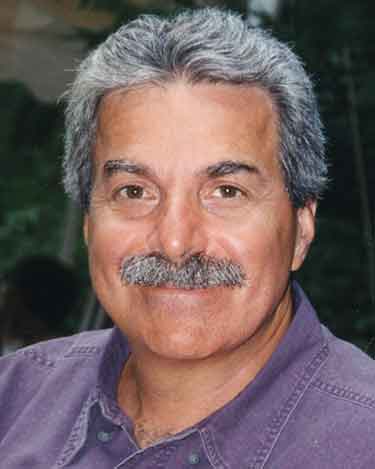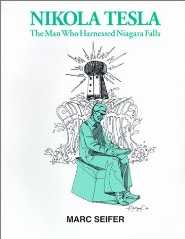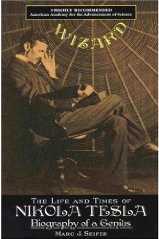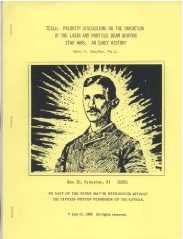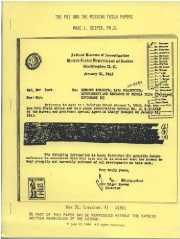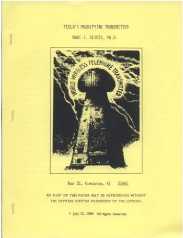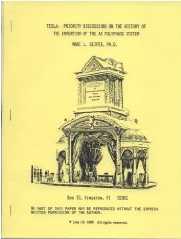Dr. Marc J. Seifer (Books)
by Marc J. Seifer
Pages: 368
Publisher: Inner Traditions
Year: 2008
ISBN: 1594772290
ISBN: 978-1594772290
Pages: 368
Publisher: Inner Traditions
Year: 2008
ISBN: 1594772290
ISBN: 978-1594772290
?Marc Seifer has made the difficult easy to understand as he covers such broad topics as cosmological coincidences, new theories on gravity, and higher states of consciousness. This book generates fresh ideas on the link between thoughts, the physical universe, and the speed of light. Transcending the Speed of Light is a bold new adventure into the exciting world of consciousness exploration.?
(Uri Geller, paranormalist )
?I highly recommend this book to any and all readers who are seriously interested in the puzzling problem of the nature of mind and consciousness. I most enthusiastically endorse Marc?s work.?
(Col. Tom Bearden (retired), author of Excalibur Briefing )
?How is it possible for consciousness to exist in the physical universe? This is the classic mind-body problem that has eluded philosophers for many generations. Now it appears that answers are within reach. The depth of Marc Seifer?s scholarship and the clarity of his thinking make this book a worthwhile read for anyone interested in the frontiers of consciousness research.?
(Jeffrey Mishlove, Ph.D., Dean of Consciousness Studies Research, University of Philosophical Research )
Product Description
A study of the new scientific understanding of consciousness and the mind as a fifth dimension of reality
? Introduces the existence of a fifth dimension--one of mind--an inner- or hyperspace where time is transcended
? Shows how the barrier of the speed of light is actually a gateway demarking the fifth dimension
Since the introduction of Descartes? dualism in the seventeenth century, the mind and the physical world have been viewed as disconnected entities. Yet qualities of mind such as awareness, purposeful action, organization, design, and even decision-making are present within the structure of matter and within the dimensions of space and time.
The space-time continuum of scientists generally ignores the realm of the mind, though phenomena such as imaginary numbers, used by Einstein to combine space with time, are concepts that only exist in the mind. Marc Seifer contends that the inadequacy of four-dimensional models to account for our experience of mental phenomena points to the consciousness of the mind as a higher organizing principle, a fifth dimension where thoughts are as real and quantifiable as our familiar physical world. He shows that because thought enables us to move backward and forward through time--reflecting on the past and making plans for the future--this fifth dimension of mind breaks the laws of relativity, thereby transcending the speed of light. His extensive study of this fifth dimension ranges from relativity and ether theory to precognition, telepathy, and synchronicity, all from the perspective of the conscious universe.
(Uri Geller, paranormalist )
?I highly recommend this book to any and all readers who are seriously interested in the puzzling problem of the nature of mind and consciousness. I most enthusiastically endorse Marc?s work.?
(Col. Tom Bearden (retired), author of Excalibur Briefing )
?How is it possible for consciousness to exist in the physical universe? This is the classic mind-body problem that has eluded philosophers for many generations. Now it appears that answers are within reach. The depth of Marc Seifer?s scholarship and the clarity of his thinking make this book a worthwhile read for anyone interested in the frontiers of consciousness research.?
(Jeffrey Mishlove, Ph.D., Dean of Consciousness Studies Research, University of Philosophical Research )
Product Description
A study of the new scientific understanding of consciousness and the mind as a fifth dimension of reality
? Introduces the existence of a fifth dimension--one of mind--an inner- or hyperspace where time is transcended
? Shows how the barrier of the speed of light is actually a gateway demarking the fifth dimension
Since the introduction of Descartes? dualism in the seventeenth century, the mind and the physical world have been viewed as disconnected entities. Yet qualities of mind such as awareness, purposeful action, organization, design, and even decision-making are present within the structure of matter and within the dimensions of space and time.
The space-time continuum of scientists generally ignores the realm of the mind, though phenomena such as imaginary numbers, used by Einstein to combine space with time, are concepts that only exist in the mind. Marc Seifer contends that the inadequacy of four-dimensional models to account for our experience of mental phenomena points to the consciousness of the mind as a higher organizing principle, a fifth dimension where thoughts are as real and quantifiable as our familiar physical world. He shows that because thought enables us to move backward and forward through time--reflecting on the past and making plans for the future--this fifth dimension of mind breaks the laws of relativity, thereby transcending the speed of light. His extensive study of this fifth dimension ranges from relativity and ether theory to precognition, telepathy, and synchronicity, all from the perspective of the conscious universe.
by Marc J. Seifer
Pages: 56
Publisher: Metascience Productions
Year: 2001
ISBN: 156649169X
ISBN: 978-1566491693
Pages: 56
Publisher: Metascience Productions
Year: 2001
ISBN: 156649169X
ISBN: 978-1566491693
Delightfil book for young readers. If you go to Goat Island at Niagara Falls, you will see a statue of Nikola Tesla inventor of the AC polyphase system, the electrical power system put in 100 years ago at Niagara Falls which is essentially unchanged today. I wrote this book to explain to young readers and adults alike Tesla's precise role in the development of this great invention. Before this invention, electrical energy could only be transported about one mile and then only for lighting homes. Afterwards, electricity could be transported hundreds of miles, and not just for lighting, but also for running household appliances and industrial machinery in factories. In addition, unlike the polluting coal operating electrical plants of that day, Tesla's invention was a clean energy creation using a renewable source of power. Before Tesla's creation, all major factories had to be located by rivers and powerful streams. Now they could be located everywhere. For these reasons, Tesla was honored by LIFE MAGAZINE by being listed as one of the 100 most important individuals of the last 1,000 years. Tesla received the Edison Medal in 1917, he was nominated for a Nobel Prize in the 1930's and he was further honored by the world when in 1956, the electrical unit the "tesla" was named after him. (MRI's measure in "tesla" units.) Thus he could stand beside such other electrical giants as Ampere, Watt and Volta. The end chapter contains an outline of my doctoral dissertation which was a treatise on why Tesla's name disappeared from the history books. THE MAN WHO HARNESSED NIAGARA FALLS is beautifully illustrated with numerous photographs and drawings from Tesla's heyday, the turn of the century, and it also contains a photograph of the Goat Island statue designed by sculptor Franko Krisnic which was given to the people of New York by the people of Yugoslavia in 1976. You've read about Harry Potter, now read about a real live WIZARD! - Amazon
by Marc J. Seifer
Pages: 542
Publisher: Citadel
Year: 1996/2001
ISBN: 0806519606
ISBN: 978-0806519609
Pages: 542
Publisher: Citadel
Year: 1996/2001
ISBN: 0806519606
ISBN: 978-0806519609
From Publishers Weekly
Seifer\\\'s vivid, revelatory, exhaustively researched biography rescues pioneer inventor Nikola Tesla from cult status and restores him to his rightful place as a principal architect of the modern age. Based largely on firsthand documents including Tesla\\\'s writings, his patents and those of competitors, it credits the Croatian-born Serb, who moved to New York in 1884, with the invention of the induction motor, long-distance electrical power distribution, fluorescent and neon lights, the first true radio tube and remote control, besides making vital contributions to the technology underlying television, wireless communication, robotics, lasers, the facsimile machine and particle-beam weaponry anticipating the space-based \\\"Star Wars\\\" defensive shield. Though often depicted as a recluse, flamboyant nouveau-riche Tesla (1856-1943) lived in Manhattan\\\'s Waldorf-Astoria Hotel for two decades, and hobnobbed with architect Sanford White, Mark Twain, Rudyard Kipling, conservationist John Muir, mogul John Jacob Astor III, Swami Vivekananda. Yet the electronic wizard, who competed fiercely with Marconi and with his one-time employer Edison, became swamped in debt, abandoned by a world he helped create, ending his days in seedy poverty, a bitter, anorexic eccentric obsessed with feeding pigeons and avoiding germs. Seifer, who teaches psychology at Community College of Rhode Island, attributes Tesla\\\'s downfall partly to his megalomaniacal, neurotic, self-destructive tendencies, partly to a quagmire of litigation and also to his Faustian pact with his ambivalent benefactor, Wall Street financier J. Pierpont Morgan, to whom he relinquished control of several patents. Morgan, suggests Seifer, stymied Tesla\\\'s visionary scheme for a global, wireless power-distribution system because, if realized, it would jeopardize electrical, lighting and telephone monopolies. Seifer provides the fullest account yet of Tesla as an entrepreneur, experimental physicist and inventor. Photos.
Copyright 1996 Reed Business Information, Inc. --This text refers to an out of print or unavailable edition of this title.
From Library Journal
Nikola Tesla is credited by many as the inventor of radio and should have received most of the credit for the development of modern electricity. Yet there is considerable confusion about his technical contributions and even more about his personal life. This book, by a professor of psychology at Bristol Community College and a member of the International Tesla Society, painstakingly documents Tesla\\\'s wide-ranging contributions. Born in Croatia, Tesla emigrated to the United States in 1884 and almost immediately began work on alternatives to what was then accepted as standard electrical technology. This brought him into conflict with Edison and later Westinghouse. The pattern of conflict continued for nearly 60 years, partially because Tesla was far ahead of his time, partially because he was erratic and off-beat, and partially because he was not an astute business partner. Seifer has analyzed extensive sources, many not previously used by other Tesla biographers, to provide a detailed interpretation of his life, but the fact that he also incorporates extensive handwriting analysis to arrive at several of his conclusions will certainly cause some reader concern. For larger science and biography collections.?Hilary Burton, Lawrence Livermore National Lab., Livermore, Cal.
Copyright 1996 Reed Business Information, Inc. --This text refers to an out of print or unavailable edition of this title.
Seifer\\\'s vivid, revelatory, exhaustively researched biography rescues pioneer inventor Nikola Tesla from cult status and restores him to his rightful place as a principal architect of the modern age. Based largely on firsthand documents including Tesla\\\'s writings, his patents and those of competitors, it credits the Croatian-born Serb, who moved to New York in 1884, with the invention of the induction motor, long-distance electrical power distribution, fluorescent and neon lights, the first true radio tube and remote control, besides making vital contributions to the technology underlying television, wireless communication, robotics, lasers, the facsimile machine and particle-beam weaponry anticipating the space-based \\\"Star Wars\\\" defensive shield. Though often depicted as a recluse, flamboyant nouveau-riche Tesla (1856-1943) lived in Manhattan\\\'s Waldorf-Astoria Hotel for two decades, and hobnobbed with architect Sanford White, Mark Twain, Rudyard Kipling, conservationist John Muir, mogul John Jacob Astor III, Swami Vivekananda. Yet the electronic wizard, who competed fiercely with Marconi and with his one-time employer Edison, became swamped in debt, abandoned by a world he helped create, ending his days in seedy poverty, a bitter, anorexic eccentric obsessed with feeding pigeons and avoiding germs. Seifer, who teaches psychology at Community College of Rhode Island, attributes Tesla\\\'s downfall partly to his megalomaniacal, neurotic, self-destructive tendencies, partly to a quagmire of litigation and also to his Faustian pact with his ambivalent benefactor, Wall Street financier J. Pierpont Morgan, to whom he relinquished control of several patents. Morgan, suggests Seifer, stymied Tesla\\\'s visionary scheme for a global, wireless power-distribution system because, if realized, it would jeopardize electrical, lighting and telephone monopolies. Seifer provides the fullest account yet of Tesla as an entrepreneur, experimental physicist and inventor. Photos.
Copyright 1996 Reed Business Information, Inc. --This text refers to an out of print or unavailable edition of this title.
From Library Journal
Nikola Tesla is credited by many as the inventor of radio and should have received most of the credit for the development of modern electricity. Yet there is considerable confusion about his technical contributions and even more about his personal life. This book, by a professor of psychology at Bristol Community College and a member of the International Tesla Society, painstakingly documents Tesla\\\'s wide-ranging contributions. Born in Croatia, Tesla emigrated to the United States in 1884 and almost immediately began work on alternatives to what was then accepted as standard electrical technology. This brought him into conflict with Edison and later Westinghouse. The pattern of conflict continued for nearly 60 years, partially because Tesla was far ahead of his time, partially because he was erratic and off-beat, and partially because he was not an astute business partner. Seifer has analyzed extensive sources, many not previously used by other Tesla biographers, to provide a detailed interpretation of his life, but the fact that he also incorporates extensive handwriting analysis to arrive at several of his conclusions will certainly cause some reader concern. For larger science and biography collections.?Hilary Burton, Lawrence Livermore National Lab., Livermore, Cal.
Copyright 1996 Reed Business Information, Inc. --This text refers to an out of print or unavailable edition of this title.
Pages 216-230 of a larger work, Nikola Tesla: Psychohistory of a Forgotten Inventor, containing Chapters
- 24: Electric Sorcerer of the Gilded Age, 216
- 25: Dematerialization Devices and Laser Beams, 222
- 26: Priority Considerations on the Development of Wireless Transmission, 230
Section 9, Chapter 48, pages 455-482 of a larger work, Nikola Tesla: Psychohistory of a Forgotten Inventor.
Section 6, "World Broadcasting System", pages 326-361 of a larger work, Nikola Tesla: Psychohistory of a Forgotten Inventor, containing Chapters
- 36: Colorado Springs and the Magnifying Transmitter, 327
- 37: Geophysics, 340
- 38: World Broadcasting System, 346

